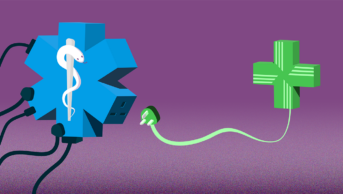
Shutterstock.com
In England, if a pharmacist sought to find out more about a patient’s care history, they could look at the patient’s summary care record to see which medicines the GP has prescribed. In Scotland, they could look at the emergency care summary, and in Wales, the Welsh GP record.
However, these records present a picture that is far from complete: the pharmacist would not see medicines that the patient’s dentist or optician had prescribed them, and they may not be able to see the medicines that the patient is receiving from a specialist outpatient clinic. This is because there is no one system that links the various NHS and private care settings. It is also very unlikely that the pharmacist would see any information about the over-the-counter medicines the patient had bought for themselves.
In short, patients can access medicines from multiple healthcare settings, making it unlikely that any one healthcare, or social care, professional will have a comprehensive list of all the medicines that a patient is taking at any one time. With the information spread across different sources, it is often poorly transferred with patients as they move between settings. This could cause medication errors, harm to the patient, and, if the patient has been admitted to hospital, increase the patient’s length of stay[1]
,[2]
,[3]
.
Prescribing errors are common at hospital admission, when it is difficult to access information about a patient’s medication history from primary care[4]
,[5]
,[6]
. In 2011, a study across three NHS organisations suggested that prescribing errors occur in up to 15% of inpatient medication orders and in 9% of medications prescribed when the patient is discharged; healthcare professionals involved in the study suggested that a lack of available medication history was a contributing factor[7]
.
The immediate involvement of pharmacists after a patient is admitted can reduce the likelihood of these errors occurring
There are few UK studies to suggest the extent of the harm that these errors could lead to; however, in March 2007, the National Reporting and Learning System for England and Wales reported 7070 medication errors involving admission and discharge — of which, 2 lead to fatalities, while 30 caused severe harm[3]
.
The immediate involvement of pharmacists after a patient is admitted can reduce the likelihood of these errors occurring[6]
. And, through the discharge medicines review, community pharmacists can reduce the risk of the patient being readmitted by making sure medicines prescribed (or stopped) in one setting continue to be prescribed (or stopped) at home[8]
.
We pharmacists, therefore, rightly consider medicines safety a major part of our role, but we must not forget the role patients can play too — after all, the patient is the only person present at every stage of their interactions with different healthcare settings. Currently, the idea of involving patients more heavily in their medicines as an approach to reducing errors has not been widely studied, but evidence is emerging[9]
.
Research suggests that patients who carry a record of all the medicines they are taking are helping to plug the gaps left in the transfer of their medicines information, meaning that they are contributing to their own medication safety[10]
.
Improving safety and effectiveness
In 2018, we worked with a group of researchers from Imperial College Healthcare NHS Trust and University College London to explore the information that patients hold on their medicines[10]
.
We interviewed 60 patients (or parents of paediatric patients) who had their own medication list, which we defined as any tool that allowed a list of current medications to be edited and carried by the patient, whether this was paper or electronic[10]
. The interviews suggested that, for those who carried them, these tools could improve the safety and effectiveness of medicines use.
For example, one patient told us they had shown their list to a doctor who was going to prescribe them a new medicine. The doctor then explained that the medicine they intended to prescribe would have interacted with a medicine that the patient was already taking; the doctor subsequently chose a different medicine instead.
It can be draining to repeat the same information to different healthcare professionals; having a list made this process simpler
We also saw how these tools can improve communication between patients, social care and healthcare professionals. For example, the mother of a patient shared an instance in which she was away with her family, while her son, who has learning disabilities, stayed in respite care. She was alerted that her son had been admitted to hospital and described her relief at having left comprehensive records of his complex medication regimen with those caring for him.
In another example, the father of a patient described how it can be draining to repeat the same information to different healthcare professionals; having a list made this process simpler.
We also learned of other benefits in holding these tools. They often served as useful reminders to order repeat prescriptions and they made patients more aware of their treatments, which helped them feel more in control of their health; research suggests that patients who are empowered in their own care have better health outcomes[11]
.
We sought to quantify these findings in a survey of 100 patients taking antihypertensive medicines; 57 reported that they carried a list and 55 (96%) of these told us it had been helpful. The benefits most commonly reported were ease of communication of medicines to healthcare professionals (21 patients) and, in an emergency, helping healthcare professionals know which medicines a patient is taking (21 patients).
And, in 16 interviews with hospital pharmacists; doctors and nurses; community pharmacists; GPs and practice nurses; and dentists and opticians, we found that healthcare professionals generally valued these lists and felt they played an important part in aiding medicines reconciliation[10]
.
There is no one-size-fits-all
Little research has been conducted into the types of tools that patients use to record their medicines, so we wanted to find out what patients are using.
The patients in the study reported variation in how they prefered to store their medicines information. Some participants carried paper-based tools, such as a repeat prescription, a discharge letter from hospital or a diary in which they had written a list of their medicines[10]
. Others used electronic formats — for example, by listing their medicines under a contact profile called ‘Medicines’ on their phone’s contact list, by recording on the notepad function on their smartphones, or though apps specifically designed to record medicines.
The patients chose tools based on their own needs. For some, a smartphone is preferable, since it is generally with the user and can be easily edited, while paper tools could become worn and ripped[10]
. Paper tools, however, are more flexible in their use, accessible, and present a useful tool for people who may not possess a smartphone or may not feel comfortable using smartphone technology[10]
.
Finding the best tool
We sought to find out which tools had features that could enhance patient safety, which we defined as being editable and customisable; listing current medicines, including their generic names and strengths, when the medicine is taken, formulation, indication and allergies; as well as having free-text boxes for each medicines and for the patient overall. In total, we assessed 103 tools, including 57 apps, 42 paper-based tools and 4 websites. No single tool had all the features we looked for, but paper tools generally fared better against our essential features, particularly for their editability and customisability. However, electronic tools were better for some features users sought, such as being able to set reminders.
Healthcare professionals reported medication lists would be very useful in reducing errors during emergency situations
During a closer look at four of the most common tools we came across, five out of seven usability testers (who were either members of the public taking medicines for long-term conditions or had a healthcare professional background) also preferred paper-based tools. With smartphone-based tools, testers were frustrated that they could not insert information in the way they wanted to — including information that could reduce prescribing errors. Although these numbers are small, they support the findings of our featured assessment.
In our interviews, a strong theme around the use of medication lists in emergencies emerged. Healthcare professionals reported medication lists would be very useful in reducing errors during emergency situations, when the patient may not be able to provide the information themselves. Paper-based tools that are kept with the patients can be accessed easily in an emergency. Access to digital records is not so easy; only two digital tools had a feature that allowed access without first entering the phone’s password.
A disconnect between needs
Most patients reported that they assumed healthcare professionals would know the purpose of each medicine they were taking
The National Institute for Health and Care Excellence’s guideline on medicines optimisation recommends that healthcare professionals share several relevant pieces of information when a patient moves between care settings, including medicines’ names, dose and purpose[3]
. Most of the healthcare professionals we interviewed valued this information, as well as any medicine-related allergies.
The vast majority of patients listed names, doses and allergies (if they had any) in their record, but very few listed indication. Most patients reported that they assumed healthcare professionals would know the purpose of each medicine they were taking, and they did not necessarily know that the same medicine could be prescribed for different reasons.
Unaware of the benefits
In our focus groups, we also talked to patients who did not carry any information about their medicines, to find out why; most patients reported that they were not aware of the benefit this could have. They often believed that all NHS systems were connected and that any healthcare professional could access their complete records from anywhere. During our interviews, we found that some patients carried extensive information about their medicines, but they had never shown this to healthcare professionals, since they had never been asked to.
Recommendations for healthcare professionals
Pharmacists — with their expert understanding of medicines — are the perfect healthcare professionals to help patients understand the type of information that they should be capturing
Patients and their carers may assume that all information pertaining to a patient’s medicines can be found on a central, all-encompassing NHS system; however, this is not the case. We should share with patients the benefits of carrying their own information about their medicines as they move through the healthcare system, showing that we value this. We should also ask to see patients’ lists during consultations.
We must be aware of the different tools available, so that we can encourage patients and carers to carry their own list, and help them to find a tool that works for them; paper-based tools may be preferable for some, but we must remember that one size does not fit all. Ideally, patients should be encouraged to record indication, and developers of electronic tools should include this as a specific field.
Pharmacists — with their expert understanding of medicines — are the perfect healthcare professionals to help patients understand the type of information that they should be capturing. We can empower patients in the knowledge that holding this information about themselves could contribute to preventing serious errors in their own care.
Sara Garfield, research pharmacist, Imperial College Healthcare NHS Trust; University College London School of Pharmacy
Bryony Dean Franklin, professor of medication safety, UCL School of Pharmacy; executive lead pharmacist (research), Imperial College Healthcare NHS Trust
Acknowledgements: Mike Etkind, Fran Husson, John Norton, Della Ogunleye, Marney Williams, Barry Jubraj, Dominic Furniss and Mohini Kanji
References
[1] Mueller SK, Sponsler KC, Kripalani S et al. Arch Intern Med 2012;172(14):1057–1069. doi: 10.1001/archinternmed.2012.2246
[2] Kwan JL, Lo L, Sampson M et al. Ann Intern Med 2013;158:397–403. doi: 10.7326/0003-4819-158-5-201303051-00006
[3] National Institute for Health and Care Excellence. 2015. Available at: https://www.nice.org.uk/guidance/ng5 (accessed May 2020)
[4] Shandilya S, Nizamuddin K, Faisal MW et al. Clin Med 2015;15(1):12Â−14. doi: 10.7861/clinmedicine.15-1-12
[5] Seden K, Kirkham JJ, Kennedy T et al. BMJ Open 2013;3(1):e002036. doi: 10.1136/bmjopen-2012-002036
[6] Tully MP & Buchan IE. Pharm World Sci 2009;31:682. doi: 10.1007/s11096-009-9332-x
[7] Franklin BD, Reynolds M, Shebl NA et al. Postgrad Med J 2011;87(1033):739−745. doi: 10.1136/pgmj.2011.117879
[8] Mantzourani E, Nazar H, Phibben C et al. BMJ Open 2020;10(2):e033551. doi: 10.1136/bmjopen-2019-033551
[9] Garfield S, Furniss D, Husson F et al. BMJ Qual Saf 2020;In press. doi: 10.1136/bmjqs-2019-010194
[10] Garfield S, Jheeta S, Husson F et al. PLOS ONE 2016;11(4):e0153721. doi: 10.1371/journal.pone.0153721
[11] Hibbard J & Gilburt H. 2014. Available at: https://www.kingsfund.org.uk/publications/supporting-people-manage-their-health (accessed May 2020)


